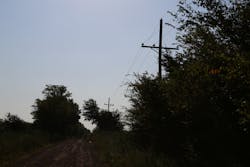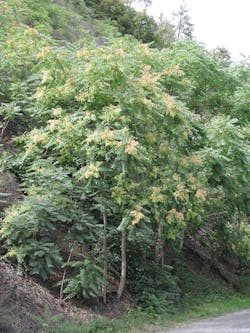Planted extensively throughout the United States in the 19th century, tree-of-heaven (Ailanthus altissima) poses a formidable threat to electrical transmission reliability. Since this invasive species adapts to a variety of ecological sites, Corteva Agriscience is helping industry professionals identify and control it effectively. In addition to vegetation management products and solutions provided by Corteva, the following insights can help industry practitioners protect utility infrastructure from Tree-of-Heaven without causing harm to native plant communities.
Why tree-of-heaven is a problem
Utility rights-of-way (ROW) are no place for tall-growing trees — and tree-of-heaven is no exception. As this invasive species commonly grows up to 80 feet tall, it can fall or grow into overhead powerlines if vegetation managers neglect to control it properly throughout and along ROW corridors. Other key attributes that make tree-of-heaven a tough-to-control nuisance for utility vegetation managers across the country include the following:
· Each female tree produces more than 300,000 seeds on average
· High seed viability supports annual tree development
· The ability to adapt to various ecological sites supports versatile development in most urban and natural areas
· Resprouting from roots makes mechanical control methods ineffective over time
What does tree-of-heaven look like?
Aside from the fact that female tree-of-heaven bear seeds (males do not), the following features commonly apply to all tree-of-heaven specimens:
Bark and Branches
Tree-of-heaven bark features a smooth gray surface. The tree’s twigs and branches are usually lighter brown in color.
Leaves
Tree-of-heaven’s alternating compound leaves can grow up to 4 feet long, and each leaf is composed of up to 40 leaflets. While leaf margins lack teeth for the most part, the lower margin commonly features one or more glandular teeth.
Flowers
As a dioecious species, tree-of-heaven predominantly features different flowers on male and female species. However, unisexual flowers have been reported on certain specimens. In any case, tree-of-heaven flowers are usually yellow or green and appear in large terminal clusters. In late summer, female tree-of-heaven produce single-seeded fruit that take on a flat and twisted appearance.
How to manage tree-of-heaven effectively
Since tree-of-heaven is a prolific seed spreader and resprouter, breaking or cutting the tree only stimulates regrowth. This makes the exclusive use of mechanical control methods an ineffective solution for vegetation managers working to keep utility ROW corridors clear of threats to surrounding infrastructure, especially after taproot development.
If a seedling is detected early enough, the entire root system can be removed by pulling or digging. Otherwise, the following treatment methods are recommended for tree-of-heaven control during later stages of plant development:
Foliar Herbicide Application
Utility vegetation managers and their contract partners can use a high-volume foliar herbicide application to treat a tree-of-heaven infestation in a cost-effective manner. Applying TerraVue® herbicide from Corteva Agriscience at 2 to 2.85 ounces with 16 to 32 fluid ounces of Garlon® 4 Ultra herbicide per treated acre can extend tree-of-heaven control following full leafout.
Cut-stump Treatment
After cutting down tree-of-heaven, vegetation managers can treat the remaining stump with a cut-stump application to ensure long-term control of the entire tree. For this treatment method, licensed applicators are encouraged to apply Garlon® 3A herbicide or Vastlan® herbicide from Corteva Agriscience either undiluted or in a 1:1 ratio with water. Alternatively, Garlon 4 Ultra herbicide can be applied at 20% volume/volume in basal oil.
Spray or paint all the exposed cambium layer on the freshly cut surface, and ensure the cambium area next to the bark is completely wet after application. Root suckering may still occur following cut-stump treatment.
Basal Bark Treatment
A basal bark treatment is recommended for stems less than 6 inches in diameter and can be completed with a backpack sprayer or power spraying equipment (20 to 40 psi). To start, mix 20 to 30 gallons of Garlon 4 Ultra herbicide with enough oil to make 100 gallons of spray mixture. Then apply the spray solution with a flat fan or solid cone nozzle from the lower 12 to 15 inches of bark to the ground level. Be sure to thoroughly wet the indicated area and spray until runoff at the ground line is noticeable.
Aside from periods when snow or water prevent spraying to the ground line, basal bark treatments can be used at any time of year to control tree-of-heaven and other invasive trees or brush species.
Hack-and-squirt Method
Another approach to ensuring tree-of-heaven control is the hack-and-squirt method. Vegetation managers can execute this strategy by making cuts around the tree trunk at a convenient height with a hatchet or similar equipment so that cuts overlap slightly and make a continuous circle around the trunk. Thereafter, spray Garlon 3A or Vastlan herbicide undiluted or in a 1:1 ratio with water into the pocket created by each cut between the bark and the inner stem or trunk.
It’s important to note that using these methods to control tree-of-heaven throughout utility ROW supports more than electrical service reliability. Suppressing the regeneration of this invasive species enables vegetation managers to promote the development of low-growing beneficial plant species that are compatible with not only utility infrastructure, but also surrounding wildlife. As an added benefit, helping native plant species flourish prevents the reestablishment of invasive species, which can effectively reduce ongoing maintenance costs.
To learn more about the positive impact herbicide applications can provide to the environment as well as utility companies and their vegetation management partners, visit HabitatWithHerbicides.com.
TM ® Trademarks of Corteva Agriscience and its affiliated companies. Under normal field conditions, TerraVue® is nonvolatile. TerraVue has no grazing or haying restrictions for any class of livestock, including lactating dairy cows, horses (including lactating mares) and meat animals prior to slaughter. Label precautions apply to forage treated with TerraVue and to manure and urine from animals that have consumed treated forage. TerraVue is not registered for sale or use in all states. Contact your state pesticide regulatory agency to determine if a product is registered for sale or use in your state. Consult the label for full details. State restrictions on the sale and use of Garlon 4 Ultra apply. Consult the label before purchase or use for full details. Always read and follow label directions. © 2022 Corteva.
Sponsored By:



